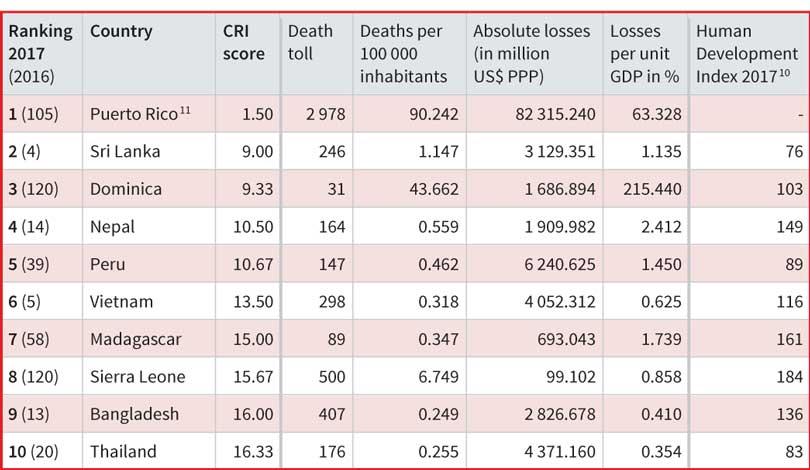05 Mar 2019 - {{hitsCtrl.values.hits}}

 “You can build all the megapolises you want, but unless watersheds that provide these megapolies with water are not protected, they will become unsustainable”
“You can build all the megapolises you want, but unless watersheds that provide these megapolies with water are not protected, they will become unsustainable”
- Dr. Eric Wickramanayake
Most Sri Lankans consider themselves fortunate to be living in a country with more or less the same climate throughout the year. Snowstorms and volcanoes have not bothered us so far. Yet, heavy rainfall, floods and long droughts are frequent occurrences. Quite evidently, the rates of these natural hazards have been observed to have increased significantly over the past ten years, leading to Sri Lanka being positioned second in the recent ranking based on vulnerability to climate change. Germanwatch, publishing the 2019 Long-Term Climate Risk Index has revealed this information at the climate summit held in Poland on December 5.
Climate change is defined as the change in global or regional climate patterns. Factors such as biotic processes, variations in solar radiation received by Earth, and certain human activities have been identified as primary causes of ongoing climate change, often referred to as global warming. Scientists and environmentalists actively work to understand past and future climate by using observations and theoretical models, the study conducted by the Germanwatch being such a research revelation. The index analyses to what extent countries have been affected by weather-related events, such as storms, floods, heat waves and others. The index is an analysis based on one of the most reliable data sets available on the impacts of extreme weather events and associated socio-economic data.
Are we really at risk?
According to Dr. Eric Wickramanayake, Chairperson and Director of the Environment Foundation Ltd, the study results are not shocking because for a few years now, Sri Lanka has topped the ranking of climate change vulnerable countries. Sri Lanka has ranked second because of the series of extreme weather events – like the powerful storms that caused heavy rainfall especially in the Southwest, that resulted in floods and landslides; and on the other hand, the continued drought in the Northern and North central part of the country which occurred throughout four consecutive years.

We must expect much more severe weather events like hurricanes, cyclones and high rainfall which will happen more frequently and unpredictably
Dr. Eric Wickramanayake
What does this mean for Sri Lanka?
Dr. Wickramanayake stated that according to analyses that have been carried out, we must expect much more severe weather events like hurricanes, cyclones and high rainfall which will happen more frequently and unpredictably. He further specified that the rainfall would take place in short periods of time, but in heavy volume, and the storms could be unpredictable and strong, followed by landslides and floods. The storms can also cause coastal erosion posing a threat to the infrastructure along the coastlines.
In terms of the climate, he expressed that we are on a dangerous trend line, where the overall temperature can increase throughout the island.
What brought this ranking, and how could we mitigate the risk?
Dr.Wickaramanayake opined that many practices in Sri Lanka contribute towards climate change, and the State blithely allows for them to take place. Citing a few examples, he referred to the deforestation in mountain watersheds, converting mangroves to prawn farms, removal and flattening of sand dunes by hotels to enjoy unobstructed views of the ocean, dynamiting coral reefs as unsustainable coral reefs done for short-term profits for the benefit of a few people, but having a huge societal cost.
In order to deal with the adverse effects of climate change, he stated that we need to focus on adaptation to climate change by building resilience and reducing vulnerabilities. He opined that natural ecosystems (forests, coral reefs, mangroves and sand dunes are important lines of defence against the consequences of climate change. According to him, the current third Climate Adaptation Plan 2016-2025 prepared by the Climate Change Secretariat of the of the Ministry of Mahaweli Development and Environment, recognizes the importance of biodiversity and ecosystems and their roles in climate adaptation; however, like all plans with good intentions, this plan also seems to have been shelved.
“Cities and towns have to be built to accommodate people and economic development. But we need to make sure that it is undertaken in a strategic way, so it is adaptive in a world that is impacted by climate change, and take advantage of the resilience conferred by ecosystems and their services. You can build all the megapolises you want with a skyline of high rise buildings. But unless you take care of the watersheds and water towers that provide these megapolises with water, they will become unsustainable.”
Dr. Wickramanayake reminded the obligations made by the Government to the Conference of Parties at the UN Climate Change Conference held in Paris 2015 to increase forest cover to 30% and also the obligation to restore 200,000 hectares of forests as forested landscape towards the Bonn Challenge.

The national action plans and nationally determined contributions are not properly implemented because institutions lack awareness on climate change
Dr. Kokila Konasinghe

How adequate is the national legal framework?
Asked about how the laws and policies in Sri Lanka can respond to the matter, Dr. Kokila Konasinghe, Lecturer of International Environmental Law at the Faculty of Law, University of Colombo stated that development of law and policy is very slow. She stated that although it is claimed that the Climate Change Act is in the final stage of drafting, she has not seen the draft. According to her, the main policies that are in place are the Climate Change Policy, National Adaptation Plan and the Intended Nationally Determined Contributions. It was expressed that even though there is a plan by the Climate Change Secretariat under the Third National Communication to make Provincial Adaptation Plans to bridge the policy gap between national and sub-national level climate action, the legal and budgetary aspects for this are not yet finalized.
“The national action plans and nationally determined contributions are not properly implemented because institutions lack awareness on climate change. It is not a priority.”
She further expressed that there is an alarming lack of coordination between national level and sub-national level institutions. She pointed out that a lack of an institution that has the mandate to actively engage in climate policy making, supervision, monitoring and evaluation is another reason for the lack of policy formulation and implementation.
What actions are in play to avoid risk of climate change?
Sujith Rathnayake, Assistant Director, Climate Change Secretariat attached to the Ministry of Mahaweli Development and Environment stated that alongside the National Climate Change Adaptation Plan 2016-2015, the Secretariat has undertaken adaptation plans in the provincial and local government level.
According to Mr. Rathnayake, there are adaptation and mitigation plans and strategies that authorities like the Urban Development Authorities have embarked upon, and the Climate Change Secretariat is working towards integrating their plans and policies into them. In example, a climate smart city is planned to be established in Kurunegala with the assistance of the Swedish Development Corporation and the Korean Ministry of Technology.
“A Bill on Climate Change has been submitted, and if it is passed in Parliament, relevant authorities will be empowered legally to take certain actions.”

A climate smart city is planned to be established in Kurunegala with the assistance of the Swedish Development Corporation and the Korean Ministry of Technology
Sujith Rathnayake
Nevertheless, it was admitted by Mr.Rathnayake that his office is limited to policy making, although baseline workshops are conducted by them, certain other authorities like the Department of Agriculture, Department of Meteorology and Ministry of Disaster Management are also responsible for the implementation of plans and conducting ground level work.
Mr. Christy Lal Fernando, Additional Secretary (Administration) of the Ministry of Disaster Management, stated that measures have been taken to prepare the country to face intensified disasters that can happen this year based on the findings of the Germanwatch. He explained in brief that there are four institutions working towards this; which are the Disaster Management Centre (DMC), the Department of Meteorology, the National Building Research Organization (NBRO) and the Department of Irrigation. While the Department of Meteorology is dedicated to give a correct forecast in this regard, he assured that the DMC is engaged in many mitigation protects. According to Mr. Fernando, the NBRO has already identified more than 2000 landslide prone areas and has made the residents of such areas aware. Measures have also put in place to evacuated about 15,000 families living in areas vulnerable to landslides and resettle them elsewhere. As stated by Mr. Fernando, the Irrigation department obtain measure rainfalls in order to be aware of floods.
“We cannot prevent disasters. What we can do within our mandate is to take precautionary measures. Our goal is to make people adaptable to disasters and help cope with them.”
27 Oct 2024 4 hours ago
26 Oct 2024 8 hours ago
26 Oct 2024 26 Oct 2024
26 Oct 2024 26 Oct 2024
26 Oct 2024 26 Oct 2024